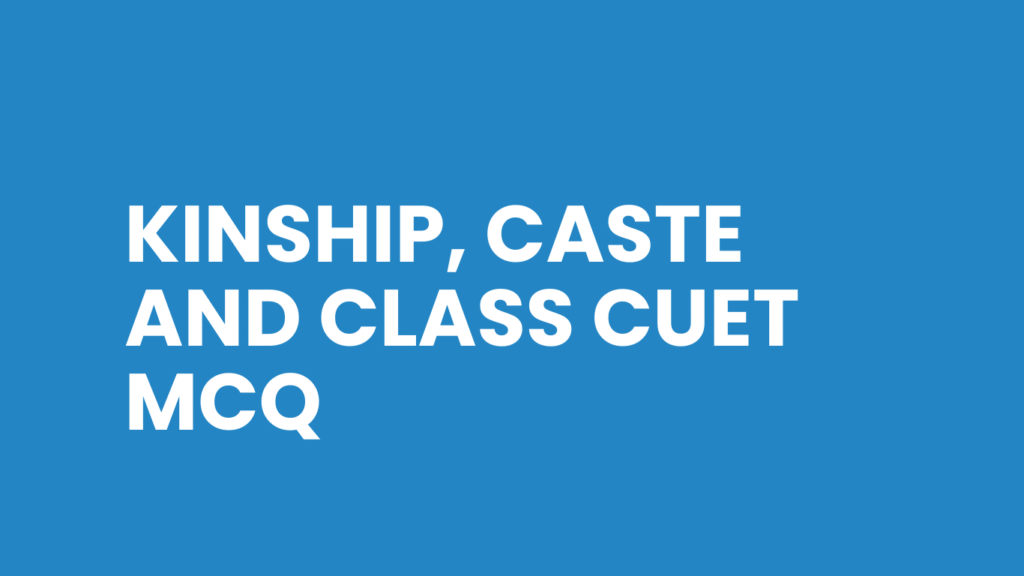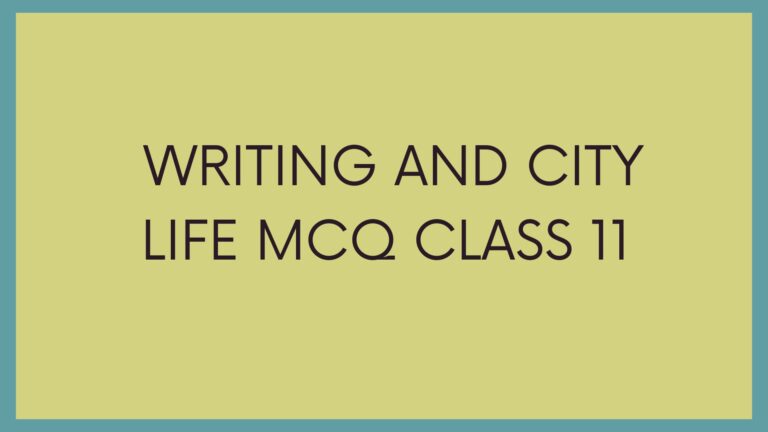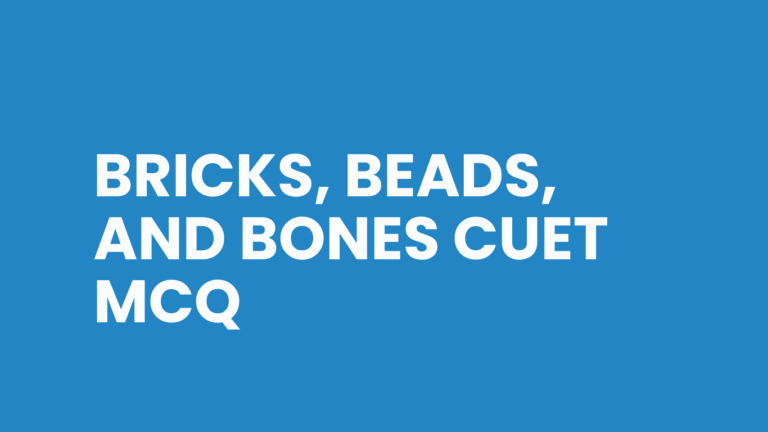Kinship, Caste and Class CUET MCQ | Class 12 History Chapter 3 Important MCQ for CUET 2026
This article will provide you with Kinship, Caste and Class CUET MCQ. Class 12 History Chapter 3 Important MCQ for CUET 2026 is very helpful for the students who are preparing for CIET 2026 and is going to choose history as their domain subject. Practicing MCQ is crucial because the pattern of CUET only has MCQs.

I have personally used these Kinship, Caste and Class CUET MCQ for my own preparation and get good grades. You can also use this for the same.
Kinship, Caste and Class CUET MCQ
- The later Vedic texts are mainly composed in which language?
a) Prakrit
b) Pali
c) Sanskrit
d) Tamil - The four Vedas are Rigveda, Samaveda, Yajurveda and:
a) Atharvaveda
b) Bhagavata
c) Mahaveda
d) Shukla - The term “Brahmana” in Vedic literature refers to:
a) A ritual specialist
b) A farmer
c) A warrior
d) A trader - The Rigveda was composed around:
a) 600 BCE
b) 1500–1000 BCE
c) 300 BCE
d) 200 CE - Which varna was assigned the duty of warfare and ruling?
a) Brahmana
b) Kshatriya
c) Vaishya
d) Shudra - Which varna was considered outside the Varna system?
a) Brahmana
b) Shudra
c) Atishudra/Chandala
d) Vaishya - The Dharmasutras and Dharmashastras mainly deal with:
a) Military techniques
b) Rituals and law codes
c) Trade regulations
d) Architecture - The Manusmriti is a key text of:
a) Buddhist philosophy
b) Hindu law and social order
c) Jain ethics
d) Sangam poetry - According to Dharmashastra, women were supposed to be under the control of:
a) Father in childhood, husband in youth, sons in old age
b) Mother always
c) Guru always
d) Independent after marriage - The Satavahana rulers followed the policy of:
a) Matriliny
b) Patriliny
c) Both matriliny and patriliny
d) None of these - The earliest evidence of the practice of Gotra is found in:
a) Rigveda
b) Later Vedic texts
c) Dharmashastra
d) Sangam literature - Which term in Vedic society meant a group of kin sharing descent?
a) Varnas
b) Gotra
c) Jati
d) Sabha - Polygyny refers to:
a) One woman having multiple husbands
b) One man having multiple wives
c) Neither of the above
d) Temporary marriage - Polyandry was practiced in some regions like:
a) South India
b) Punjab
c) Himalayan areas
d) Central India - The Mahabharata is sometimes described as:
a) An Itihasa
b) A Jataka
c) A Prashasti
d) A Purana - The Mahabharata was composed over a period of about:
a) 50 years
b) 200 years
c) 500 years
d) More than 1000 years - Who is considered the traditional author of the Mahabharata?
a) Valmiki
b) Vyasa
c) Kalidasa
d) Vishnu Sharma - The story of Draupadi’s humiliation is significant in showing:
a) Political power of Kshatriyas
b) Women’s position and vulnerability
c) Economic decline
d) Role of priests - The term “Niyoga” refers to:
a) Child marriage
b) Widow remarriage through levirate
c) Vedic sacrifices
d) Women’s education - The ideal of patriliny is best exemplified in the:
a) Ramayana
b) Mahabharata
c) Arthashastra
d) Sangam poetry - Who among the following rejected the caste system most strongly?
a) Gautama Buddha
b) Kautilya
c) Vyasa
d) Kalidasa - The Buddhist text that describes caste as based on actions (karma), not birth, is:
a) Jataka tales
b) Dhammapada
c) Anguttara Nikaya
d) Vinaya Pitaka - The earliest Tamil literature, known as Sangam literature, was produced around:
a) 600 BCE
b) 300 BCE–300 CE
c) 700–1000 CE
d) 1200 CE - The Tamil word “Vellalar” refers to:
a) Brahmanas
b) Ruling chiefs/landowners
c) Untouchables
d) Traders - The “Uzhavar” in Sangam texts were:
a) Brahmanas
b) Landless labourers
c) Ploughmen/peasants
d) Fishermen - The “Adimai” in Sangam society were:
a) Slaves and servants
b) Priests
c) Soldiers
d) Traders - Which of the following is considered an early example of slavery in India?
a) Rigveda
b) Sangam texts (Adimai)
c) Arthashastra
d) Manusmriti - Which text describes marriage as a sacrament, not a contract?
a) Arthashastra
b) Manusmriti
c) Sangam texts
d) Jatakas - Which social group was expected to give up agriculture and take to trade and pastoralism in later Vedic society?
a) Brahmanas
b) Kshatriyas
c) Vaishyas
d) Shudras - Which of the following correctly matches text with region?
a) Arthashastra – South India
b) Manusmriti – Tamil Nadu
c) Sangam literature – Tamilakam
d) Mahabharata – Kashmir
Answer key for Kinship, Caste and Class CUET MCQ
1-c, 2-a, 3-a, 4-b, 5-b, 6-c, 7-b, 8-b, 9-a, 10-b, 11-b, 12-b, 13-b, 14-c, 15-a, 16-d, 17-b, 18-b, 19-b, 20-b, 21-a, 22-c, 23-b, 24-b, 25-c, 26-a, 27-b, 28-b, 29-c, 30-c







One Comment